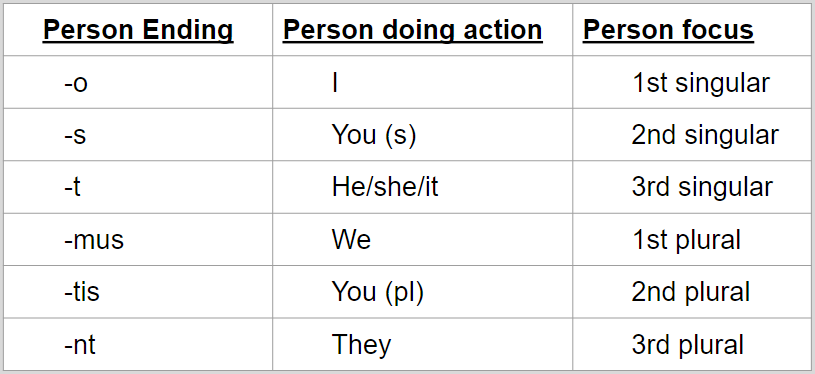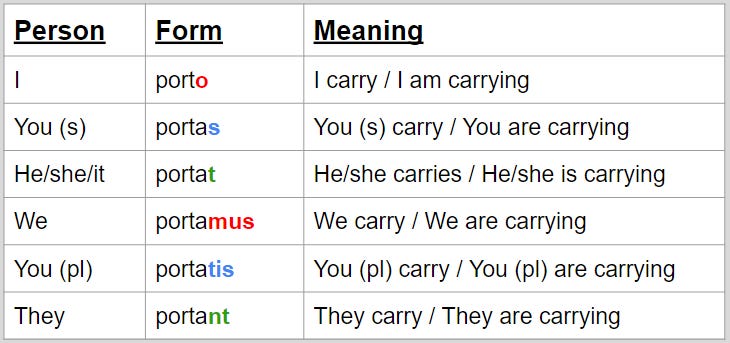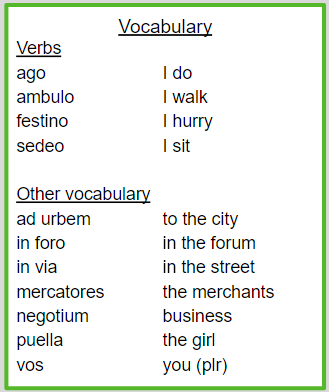Presenting the Present Tense
January Latin Challenge: Day 9 of 31
Welcome back to the January Latin Challenge on bambasbat! Today we are moving from nouns to verbs, starting with a quick look at the present tense in Latin.
Before we start, I want to give you my reference guide for verbs. It might be a bit more detailed that what you need, but as you progress onto more tricky Latin it will continue to be useful, so go and download it here to have on hand as we go along.
The Easy Tense
People always say the present tense is easy, but you would be surprised how many people make mistakes when translating it!
The most common mistakes I get when people translate present tense verbs are:
they don’t check the tense, and end up making it far too complicated; or
they do recognise that it is present but they ignore the person endings.
Endings are the most important part of Latin!
I’ve said it before and I’ll say it again, the endings of Latin words are the most important part! They tell you all the information you need to know in a sentence. So you need to know the person endings for the present tense, as all other tenses stem from this. There are patterns throughout them all.
The present tense endings in Latin:
Easy? Wrong - now you need to learn them. You also need to know who that relates to - so many people can chant that ending sequence to me, but get muddled on what the order relates to.
In the table above, you can see the person that each ending relates to. In order, they mean: I, you singular, he/she/it, we, you plural, they.
If that’s a bit tricky, you can also think of it as 1st, 2nd, and 3rd person singular, then 1st, 2nd, and 3rd person plural.
I know the endings, now what?
Let’s look at this verb as an example:
porto, portare
To fit the present tense person endings onto a verb, take the 1st person singular (the I form), and remove the -o.
Now you need to add a thematic vowel. We decide what the thematic vowel is based on the infinitive of a verb. In the case of the verb porto, the infinitive is portare - to carry. I take off the -re and I get porta- as the present stem. Then all you do is add the person endings!
I end up with a table that looks like this - the present tense of portare (to carry)
Different person endings
Have a go at changing these verbs into the person I have stated - on the left is the 1st person singular (the I form). I have added in brackets the infinitive, to help you find the thematic vowel you need. On the right is the form I want you to put it into.
rideo (ridere) - You (s) laugh
ambulo (ambulare) - She walks
canto (cantare) - We sing
audio (audire) - They hear
The answers are below, so only continue reading when you are ready!
I need the you singular form of “to laugh”. To do this I take the -re off the infinitive ridere and add my -s ending - this gives me rides.
I want the 3rd person singular (he/she/it) form of ambulo. Again I take the -re off ambulare and add the -t ending. I get ambulat
I want the we form of canto. Take off the -re from the end of cantare, add the -mus ending, and I have cantamus.
Finally the they form of audio, I hear. This one is a bit of a trickier one. Again, take the -re off the infinitive. This leaves me with audi-. By my usual method, I would add the -nt ending and have audint. However, the Romans didn’t like the sound of that, so for verbs that have -ire as the infinitive ending, we have to add the letter -u- after the -i- and before the -nt. This gives me audiunt.
This is only for the 3rd person plural (they), so don’t panic, but it is something to keep in mind.
Let’s have a look at some examples in Latin.
In Latin sentences the verb is usually at the end of a sentence or clause. As usual, I have the vocabulary below in the green box. In the vocab, you might notice all the verbs are glossed in the 1st person singular - the “I am doing it” form. This is how you will see verbs in a dictionary, so get used to that!
puella in via sedet.
ad urbem festino.
mercatores negotium agunt.
vos in foro ambulatis.
Explanations and translations below, only read on when ready!
puella in via sedet. My verb is sedet. It ends with -t, so I know it means he/she or it doing my verb: he/she/it sits. puella is a nominative noun, so it takes the place of the word “she” here - I don’t need both, so I just say “the girl sits”. Then finish it off with in via - “the girl sits in the street”.
ad urbem festino. My verb is festino here. This ends in -o, which is the 1st person singular ending: I hurry. Finish it off with ad urbem, “I hurry to the city”
mercatores negotium agunt. Always do the verb first - agunt. This is the 3rd person plural ending, so “they do something”. Now let’s check, do I have a nominative that can take the place of the word they? Yes! mercatores is my nominative. This sentence means “the merchants do business”.
vos in foro ambulatis. My verb in this sentence is ambulatis. Now this looks like it’s a 2nd person singular, because it ends in -s.
However, if you look at the vocab you can see that the 1st person I form has the stem ambulo. This means that when I take off the -o and add a thematic vowel, (ambula) everything after that is my ending. So here, I have -tis, not just -s on the end. This is a 2nd person PLURAL, not a 2nd singular.
vos is a pronoun that can help me - it means “you plural”. If it helps you can learn this ending as “you all”, or “y’all” if you fancy it, but make sure you don’t write that down in any translations! Back to the sentence - vos ambulatis in foro: “you plr walk in the forum”.
And that’s the present tense in Latin!
Don’t forget you can download the free reference guide for verbs here. It will really help you to make sense of all the different forms of verbs.
I hope this was useful to you, let me know if you have any questions, and I’ll see you tomorrow on bambasbat for Day 10 of the January Latin Challenge! Subscribe here so you don’t miss it!




